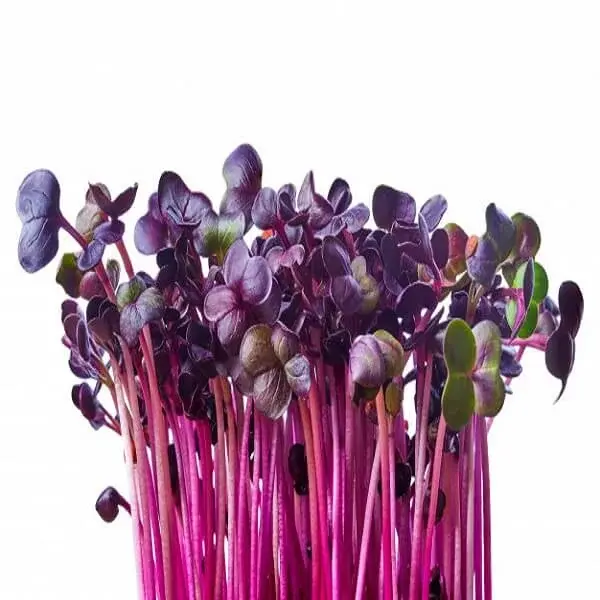Microgreens and Cancer Prevention: A Deep Dive into Their Antioxidant and Phytochemical Properties
- mikrogrens

- Sep 24
- 4 min read
Research keeps showing how important food is for managing and preventing cancer, which is still one of the most difficult diseases in the world. Microgreens, which are tiny, nutrient-dense greens picked just a few days after germination, are one of the nutrition industry's emerging stars. These young plants, including radish microgreen and pea microgreen are rich in antioxidants, vitamins, and phytochemicals that may help lower the risk of cancer making them far more than simply trendy garnishes.

What Are Microgreens?
Vegetable and herb seedlings known as microgreens are usually picked 7–21 days after germination. According to research, they have up to 40 times as many nutrients as their adult counterparts, despite their diminutive size. Known for their health-promoting properties, popular types of microgreens include kale, cabbage, beetroot, spinach, broccoli, and radish.
Antioxidants and Their Role in Cancer Prevention
Free radicals create oxidative stress, which is one of the primary factors that leads to the development of cancer. Antioxidants aid in preventing damage to cells by neutralizing these dangerous chemicals. Antioxidants found in microgreens, particularly pea microgreen, include:
The immune system is strengthened by vitamin C.
Vitamin E protects cells from oxidative damage.
One vitamin A precursor with potential anti-cancer effects is beta-carotene.
Plant substances called polyphenols are linked to a lower risk of cancer.
Phytochemicals: The Natural Cancer Fighters
Plants contain bioactive substances called phytochemicals that can help prevent cancer and other chronic illnesses. Microgreens are particularly abundant in:
Sulforaphane This substance, which is present in broccoli and cabbage microgreens, has been well researched for its capacity to suppress the growth of cancer cells and increase detoxification enzymes.
Flavonoids: Flavonoids, which are found in microgreens like spinach, kale, and beets, aid in controlling cell signaling and lowering inflammation.
Glucosinolates: Found naturally in cruciferous vegetables such as mustard microgreens and radish, glucosinolates decompose into chemicals that may offer some carcinogenic protection.
Scientific Evidence Supporting Microgreens and Cancer Prevention
Broccoli microgreens are a potent option for cancer prevention since they have far higher quantities of sulforaphane than mature broccoli.
The glucosinolates included in radish microgreens may help the body rid itself of toxic toxins.
Beetalains, which have anti-inflammatory and antioxidant properties, are found in beetroot microgreens.
According to these results, eating microgreens on a regular basis may help prevent cancer in the long run.
Easy Ways to Add Microgreens to Your Diet
It's easy and tasty to incorporate microgreens into your dishes. You can:
Add them to sandwiches, soups, and salads.
Blend them into drinks or smoothies.
Top your rotis, curries, and pulao with microgreens for extra nutrition.
With a microgreen DIY kit, you can grow your own at home and guarantee a fresh supply all year long.
How Microgreens Support the Body Against Cancer
1. Assistance with Detoxification
Cruciferous microgreens (radish, cabbage, broccoli, red cabbage) include compounds like glucosinolates and sulforaphane that increase the liver's detoxifying enzymes.
This improves the body's ability to eliminate carcinogens.
2. Inhibition of Inflammation
Prolonged inflammation is associated with the advancement of cancer.
Microgreens that are high in anti-inflammatory chemicals, such as mustard, radish, and kale, can help lessen internal cell stress.
3. Protection of DNA
Microgreens' antioxidants protect DNA from oxidative damage.
One of the most important ways to reduce the risk of cancer is to protect genetic material.
4. Strengthening of the Immune System
Microgreens are rich in vitamins A, C, and E, which strengthen the immune system.
A more robust immune system is better able to identify and eliminate aberrant or precancerous cells.
5. Smaller Portions with Higher Nutrient Density
Microgreens provide concentrated nutrients in little amounts since they are harvested young.
Why Choose Microgreens Over Supplements?
Phytochemicals from a natural source as opposed to artificial tablets.
Easier for the body to absorb.
Provide extra freshness, enzymes, and nutritious fiber that pills don't.
Practical Lifestyle Tips
Alternate types: For a greater variety of nutrients, use a blend of spinach microgreens, beets, radish, and broccoli.
Pair with meals: To optimize nutrient absorption, combine microgreens with whole grains, lean protein, and healthy fats.
Grow at home: A Microgreen DIY Kit makes it economical and sustainable by guaranteeing a steady supply of fresh greens.
Microgreens and Sustainable Health
Compared to conventional farming, growing microgreens requires less water and area.
Because they can be grown indoors, they are available in urban areas.
Promoting microgreens benefits the environment in addition to human health.
Why Microgreens Deserve a Place in Your Anti-Cancer Diet
A nutrient-rich diet can greatly reduce your risk of developing cancer, even if no single meal can totally prevent it. With their potent phytochemicals and concentrated antioxidants, microgreens are a particularly effective complement to a lifestyle that prevents cancer.
Including microgreens in your meals on a daily basis is an investment in a healthier, more resilient future, in addition to bringing taste and freshness.
Experience Nutrition Naturally with Mikrogrenz Microgreen Seeds
Shop the best microgreen seeds in India at Mikrogrenz and start growing fresh, nutrient-packed greens at home today.

















Comments